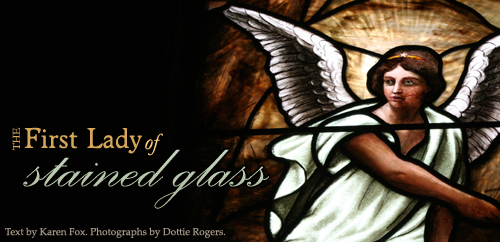|
There’s a special glow this holiday season at Cape May’s First Presbyterian
Church.
The congregation is celebrating the restoration of the church’s 110-year-old
stained glass windows. Thirty five windows, including massive 17-by-17 foot
Gothic arches, have been painstakingly, lovingly, professionally reworked. The
antique art glass was saved, while repainting and releadin g new pieces in the
brilliant colors and fine hand-painted features that make the windows so
special. The work is similar to resetting thousands of pieces of rare gems in
custom-designed jewelry, but on a massive scale. g new pieces in the
brilliant colors and fine hand-painted features that make the windows so
special. The work is similar to resetting thousands of pieces of rare gems in
custom-designed jewelry, but on a massive scale.
It was just two years ago that Dick and Dixie Barab met with 11 church members
to discuss the worsening condition of the windows, and what to do about saving
them.
Located at Hughes and Decatur streets, just a couple blocks from the sea, and
stressed by a century of storms, the windows suffered severe cracking and
bowing. The antique paint was flaking, the lead deteriorating and the wooden
frames were weakened by invading termites.
The concerned church members called their mission Save Our Stained Glass
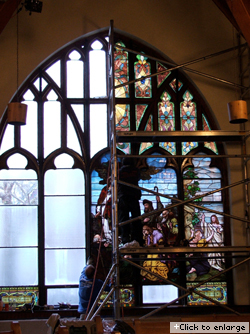 Windows. They learned the windows were created by Wilheim (William) Reith, born
in Baden-Baden, Germany, in 1844, arriving in America in 1867 at age 23. His
studio was located at 134 North 7th Street in Philadelphia. Windows. They learned the windows were created by Wilheim (William) Reith, born
in Baden-Baden, Germany, in 1844, arriving in America in 1867 at age 23. His
studio was located at 134 North 7th Street in Philadelphia.
The windows he designed for the Cape May church depict scenes from
the life Christ and stories from the Bible. The glass was painted with brilliant
reds, golds, purples, greens and blues with generous amounts of silver stain.
The paint was composed of ground glass, metallic oxide coloring agents and flux
to lower the temperature of the glass when melted.
The brilliant art windows struck awe and inspiration among congregants at the
first service in the new stone Gothic-style First Presbyterian Church, held May
21st, 1899. And now, almost 110 years later, these same restored windows filter
the light of the sun and the reflection of the sea
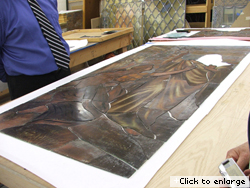 upon members and visitors at
religious services, theatrical and musical events. The church has a cultural
mission offering monthly Jazz Vespers and is home to most performances of the
East Lynne Theatre Company. upon members and visitors at
religious services, theatrical and musical events. The church has a cultural
mission offering monthly Jazz Vespers and is home to most performances of the
East Lynne Theatre Company.
For Dottie Rogers, Cape May’s First Lady of stained glass, the completed
restoration is a victory of a lifetime. She is on the committee to save the
windows. A retired school teacher and resident of West Cape May, Dottie’s goal
is to photograph every stained glass window on Cape Island. In five years, she
has organized almost 2,000 photos of stained glass
windows, their histories and
locations on her computer. And she’s always looking for more.
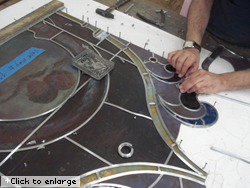 Jewels of Cape May Jewels of Cape May
Dottie says a small town like Cape May is unique to have such a variety of
stained glass. She explains “the great fire of 1878 destroyed so many structures
that in the aftermath, there was a giant building boom in the Victorian era when
stained glass was very popular in America.” During this period, Americans
developed an appetite and appreciation for this art form. Architects and
builders eagerly installed stained glass into homes, churches and public
buildings. Dottie’s most recent photos show the process of restoring the stained
glass windows at her church.
The window restoration committee chose the J&R Lamb Studio in Clifton, New
Jersey, to bring new life to the Reith windows. Lamb is the oldest continuously
 operating stained glass studio in the United States. operating stained glass studio in the United States.
Don Samick, owner, says that the Reith windows were a challenge because of
the great amount of fading paint. First these fragile giants needed to be
removed, loaded on a truck and transported to the studio. There each window is
cleaned (“just with water,” says Samick), evaluated, disassembled and laid out
like pieces of a puzzle. Detailed rubbings are made of each layer of glass.
Artists recreate faded and damaged colors and images to their original
brilliance and detail. Those new pieces are fired and then laminated in double
leading beneath the antique glass so that you see through the original glass
into the more brilliant restored glass, all blending seamlessly into one vision.
“When we arrived at Lamb,” says Dottie, “several of our windows were laid out
in pieces on tables, lead gone and pinned.” It took a leap of faith that the
artists could put these precious antiques back together again. “We had done our
homework
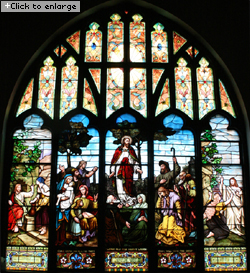 picking a studio,” says Dottie. “We had no fear.” picking a studio,” says Dottie. “We had no fear.”
The restored panels were reassembled and transported back to the church for
installation. The windows are trucked at 75-degree angles, between Styrofoam
pads, secured with straps. The large mural windows are held in place at the
church with steel T-bars anchored in the wood frames.
All of this was accomplished over 13 months and at the cost of $206,000.
Meanwhile back at the church, the committee members were busy elves coming up
with inventive ways to raise the money.
A special Jazz Vespers was held to benefit the restoration project. Local
world-class jazz musicians, pianist George Mesterhazy and singer Lois Smith,
contributed their talents. The event raised $15,000. The church members hosted
bake and yard sales and Fornight Feasting dinners, card parties, a July 4th
barbecue. Christmas bazaar profits went t o the windows. The East Lynne Theatre
Company donated a production’s proceeds. o the windows. The East Lynne Theatre
Company donated a production’s proceeds.
The most productive idea came from Bruce Jeffries-Fox and his wife Zan who
created a price-per-window list for purchase by a sponsor. ”Whether a person
contributed $1 or $1,000,” says Dottie, “every one will be acknowledged.”
Among the contributors is Lamb Studio itself. Don Samick, his artists and
craftsmen gifted the church with a window over the Decatur Street entry. “It’s
just a small piece of gratitude for a wonderful project,” says Samick. By the
way, the Cape May spirit has captured Samick and his wife Donna. They were
frequent B&B guests, but recently have purchased a home of their own in Cape
May. The Presbyterian congregation couldn’t be happier than to have their
stained glass artist in residence. “The windows will be good for another 150
years!” says he.


About Stained Glass
References to stained glass reach back to the 4th and 5th centuries, the art
form reaching its peak in the 10th – 13th centuries, especially in cathedrals.
Glass was colored by adding metallic salts while in a molten state: copper to
produce green, cobalt for blue, gold to create red, silver nitrate to color
yellow from pale lemon to deep orange.
The colored glass is crafted into stained glass windows in which small pieces
of glass arranged to form patterns or pictures are held together by strips of
lead or copper and supported by a rigid frame. The term stained glass also is
used to describe windows in which all the colors have been painted onto the
glass and then made permanent with heat.
Stained glass creation is both an art and a craft requiring the artistic
skill to develop the design and the engineering skills to assemble the
decorative piece be it a window, lamp shade, or free hanging art piece. In the
case of a window it must be constructed to support its own weight and survive
the elements sometimes for hundreds of years.
Religious conflicts and wars destroyed many complex stained glass windows
over the centuries in Europe, Asia and the Middle East.
The most prolific stained glass period in America was in the Victorian era
from the 1850s to the 1920s.
Text by Karen Fox. Photographs by Dottie Rogers. The original article,
Jewels of Cape May, first appeared in
Cape May Magazine, Winter 2007.
|
